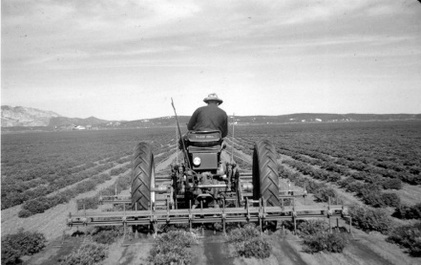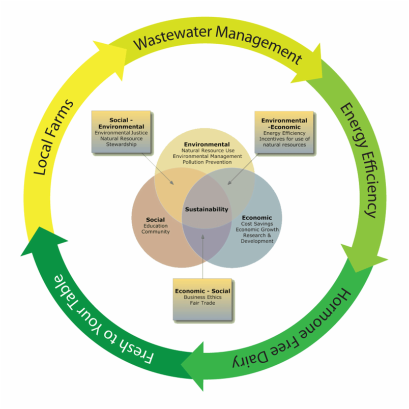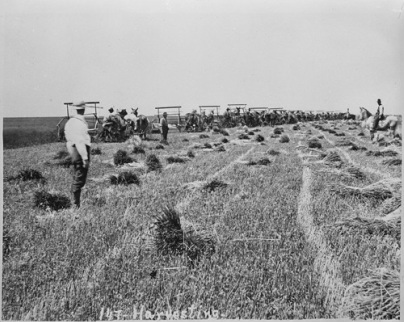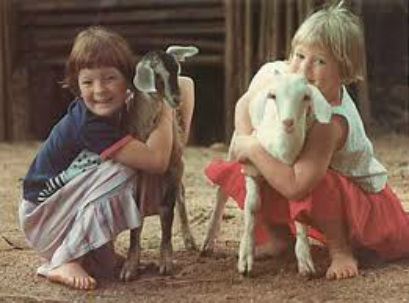
(small farms.cornell.edu)
Farming in the New Millennium Intro
Small farms are in the “right place at the right time”. Backed by the USDA and land-grant institutions, armed with business acumen, a solid moral and ethical compass, and a keen sense of direction, the small farm of the new millennium can be a force for change, both economically and culturally.
The Mission of This Website: To promote small farms as an agent for societal change through a holistic approach to farming while providing a forum in which beginning, novice, and experienced farmers can share their questions and knowledge.
Using this Website:
Small farms are in the “right place at the right time”. Backed by the USDA and land-grant institutions, armed with business acumen, a solid moral and ethical compass, and a keen sense of direction, the small farm of the new millennium can be a force for change, both economically and culturally.
The Mission of This Website: To promote small farms as an agent for societal change through a holistic approach to farming while providing a forum in which beginning, novice, and experienced farmers can share their questions and knowledge.
Using this Website:
- View the section " Considering the Key Elements For Successful Farming In the New Millenium ..." on the Home Page
- Explore each Element further by clicking the Page Links within the home page section or on the Page Menu bar
- Add your knowledge and expertise or ask a question on the Forum Page.
- Find out about our source material, explore other authors, or Contact Us directly using the Note Page (click more on the toolbar) .
___________________________________________________
Considering the Key Elements for Success.
"Creating the Small Farm for the 21st Century"

(agviselabs.com)
Science Education and Technology
(SciEdTech)
The marriage of science, education and technology has been one of the most crucial and critical elements for the advancement of farming throughout history. Research and new discoveries through science have served to create and improve new and better food crops. Education networks such as land-grant colleges, agricultural societies (National Grange, Farm Bureau) and government agencies have served to keep farmers informed and aware of trends and methodologies that constantly change in the complex world of farming. Although application of technology has always been at the core of all farming, it will take on an even greater significance in the new millenium as small farms seek to work smarter in areas as diverse as internet-marketing, innovative packaging and storage, and a plethora of ecologically-driven methodologies. for more discussion and to continue reading this section click here
(SciEdTech)
The marriage of science, education and technology has been one of the most crucial and critical elements for the advancement of farming throughout history. Research and new discoveries through science have served to create and improve new and better food crops. Education networks such as land-grant colleges, agricultural societies (National Grange, Farm Bureau) and government agencies have served to keep farmers informed and aware of trends and methodologies that constantly change in the complex world of farming. Although application of technology has always been at the core of all farming, it will take on an even greater significance in the new millenium as small farms seek to work smarter in areas as diverse as internet-marketing, innovative packaging and storage, and a plethora of ecologically-driven methodologies. for more discussion and to continue reading this section click here
Sustainability and Flexibility(SustainFlex)
No element in farming is separate from any other element, and by the same token the farm is an integral part of the environment, culture,and the society in which it exists. There is a beautiful symmetry and harmony to a farm that assumes this holistic approach. While this approach has had many detractors in its formative stages, small-to-mid-size farmers (as well as the USDA and Cooperative Extension Services) have now embraced the many ecologically favorable practices at its core as not only pragmatic and socially responsible, but also as highly profitable. Every decision and consideration made within this farm model is done within the context of its cyclical ramifications; that includes how it affects nature, the family, the "bottom line, and society at large. Additionally, waste and excess is kept to a minimum, a practice which in turn raises profitability, eliminates unnecessary work, and keeps the farm flexible and agile, able to both profit from and react to market fluctuations. for more discussion and to continue reading this section click here |

(wow1.com)
Market and Business Savvy
(MarkBus)
Small businesses in the United States have a survival rate of 70% two years after start-up, falling to less than 25% after 15 years according to SBA data. While reasons for failure are often exogenous, improper internal financial controls that allow for the reactive contingencies to market and other negative external pressures ultimately create conditions that result in these failures. Though no small business is immune to the conditions that result in failure, those that prepare themselves in terms of financial planning and management, put themselves in a position to “weather the storm” as problems occur.
Being in the right place at the right time with the right product is not just a matter of circumstance; it’s a product of research and planning.One of the main objectives of proper planning is to relegate the element of luck to the most minor status. Prior to marketing, it is important to identify what markets exist, what products work the best within these markets, and what product characteristics maximize demand and profit margins. The importance of the marketing aspect of farming cannot be understated . Not to be confused with advertising or selling, in business, a good marketing strategy creates opportunity and often means the difference between mere subsistence and making a fair profit. Marketing is a never-ending process and new market opportunities keep a farm vital and alive. Opportunities to sell are the product of good and diligent research with aggressive follow-up and in the business of farming should, in reality, be on a par with milking the cows, tilling the soil and irrigating the crops. (1) for more discussion and to continue reading this section click here
(MarkBus)
Small businesses in the United States have a survival rate of 70% two years after start-up, falling to less than 25% after 15 years according to SBA data. While reasons for failure are often exogenous, improper internal financial controls that allow for the reactive contingencies to market and other negative external pressures ultimately create conditions that result in these failures. Though no small business is immune to the conditions that result in failure, those that prepare themselves in terms of financial planning and management, put themselves in a position to “weather the storm” as problems occur.
Being in the right place at the right time with the right product is not just a matter of circumstance; it’s a product of research and planning.One of the main objectives of proper planning is to relegate the element of luck to the most minor status. Prior to marketing, it is important to identify what markets exist, what products work the best within these markets, and what product characteristics maximize demand and profit margins. The importance of the marketing aspect of farming cannot be understated . Not to be confused with advertising or selling, in business, a good marketing strategy creates opportunity and often means the difference between mere subsistence and making a fair profit. Marketing is a never-ending process and new market opportunities keep a farm vital and alive. Opportunities to sell are the product of good and diligent research with aggressive follow-up and in the business of farming should, in reality, be on a par with milking the cows, tilling the soil and irrigating the crops. (1) for more discussion and to continue reading this section click here

Americans have stubbornly clung to the myth of the rugged, independent farmer, although that era began to pass some two-hundred years ago, in direct correlation with the agriculture’s evolution from subsistence to the commodification. BELOW:The 11,000 acre Dalrylmple Bonanza Farm circa:1877. A harbinger of problems with the corporate farming model.(www.hamiltonmuseum.org)
The Moral and Ethical Pursuit of Profit (MorEthic) Exogenous factors put enormous pressures on small farmers and the success of the small farm can ultimately be predicated on the ability of owners to manage these pressures. Management strategies such as the business plan and budgeting play a large role as preemptive measures on the financial side; however there are many other forces, issues, and many unforeseen elements that must be dealt with. It is important to emphasize that although these subjects invariably all have serious financial ramifications, they go well beyond the discussion of money. Making money (profit) while simultaneously adhering to legal, moral, and social obligations can present unique challenges that must be filtered through many different lenses.The weight and complexity of having to make these everyday decisions can be enormous. As environmentally friendly and socially-conscience practices meet the onus the farmer has to society at large, they can also be a key component of a good and economically sound business plan.This new paradigm small farm model will, above all else, prove that making a fair profit and conducting business in a moral and socially-responsible manner are not mutually exclusive practices but, in fact, synergistic. for more discussion and to continue reading this section click here |
Our Farming Heritage and the Politics of American Farming(Respect)
George Santayana's famous (and often corrupted) quote states," Those who cannot remember the past are condemned to repeat it." Within the intent of this quote lies the truth that knowledge of the past leads to a greater ability to live in harmony in the present and plan for the future. Knowing and understanding the roots of agriculture is an integral component of the holistic approach to farming. Farming (and agriculture in general), in a technical sense, can trace its roots back to prehistoric times, achieving a respectable degree of scientifically-based sophistication by the early 16th century. In the United States, even prior to the Revolutionary War, farming began to transcend the actual physical acts of animal husbandry and planting, becoming woven into the very fabric of the nation itself and influencing all aspects of the society, from politics to social issues. The Erie Canal was completed in 1825, providing a supply line west and a valuable water-link to the east coast for agriculturual commodities produced in the West. In the decades preceding the Civil War, the influences of the Lyceum Movement opened the rural community to new ideas, new science, and new technology, which in turn led to a better understanding of farming as a business and farming as a science. . In the decades spanning 1840-1860 railroads expanded their tracks by ten times allowing farmers in landlocked locations transportation access. With a sophisticated and integrated transportation infrastructure in place, the influx of willing and able immigrants ( a number of them being Old-World farmers), new technology and technological research ongoing ( the Department of Agriculture was finally established in 1862 and the Morrill Land Grant College Law was passed) and land supplied by the Homestead Act, land speculators and the railroads, American agriculture, in a plethora of forms, was established from coast to coast by the end of the 1860’s. By the end of the Civil War, even as the Southern plantation system faded into obscurity, more than half of all Americans derived their income directly from farming as farm products accounted for 79% of all export revenue. In the first decade of the 20th century, farming was still the largest single sector of employment in the United States. Farming, as an industry, accounted for 58% of all exports ($917 million or $23 billion in today’s dollars) and over 30% of the population engaged in farming. This, by far, is the largest and most important component of this website because it illustrates the need for diversity and innovation in agriculture. This section underlines the importance of placing the basic tenents of farming above the greed-driven models of the recent past that have eroded the industry and tradition of farming, bringing it to a crucial tipping-point in the new millenium. (2) for more discussion and to continue reading this section click here |
|
|
Pursuit of a High Quality of Life
(Happiness) Today’s successful small farmers are pioneers on the cusp of a revolution that will redefine farming and the farming lifestyle and in the process exert a significant influence on society at large. They are intelligent, educated, and goal-oriented when it comes to running a business. What sets them apart from their counterparts in other business sectors, is their deep-rooted appreciation for the lifestyle they have chosen and their personal recognition of the value of that lifestyle that transcends considerations of material wealth. Though these farmers are often humble to the point of crediting outside forces for their success, it has ultimately been their own efforts and their understanding of the “quality of life” that has led them to their success. for more discussion and to continue reading this section click here |
Home Page Notes:
(1) SBA : "Small Business FAQ's" http://web.sba.gov/faqs/faqindex.cfm?areaID=24
(2) George Santayana Life of Reason, Reason in Common Sense. Scribner's. 1905, p. 284
(3) James Rose "American Agricultural History: Overview and Discussion of Milestones and Missteps: 1600-1900." Empire State College, paper submitted to Mark
Soderstrom mentor. (30 December 2010)
(4) USDA 2007 Census of Agriculture http://www.agcensus.usda.gov/Publications/2007/Online_Highlights/Fact_Sheets/Demographics/women.pdf




